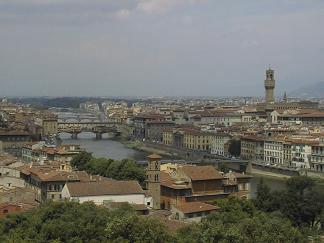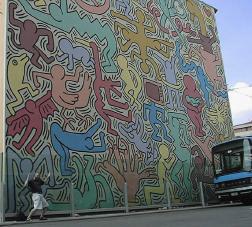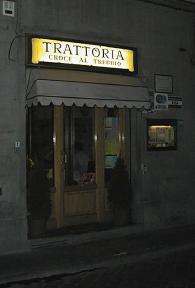
Firenze (Florence)
June 14th - June 17th, 1999

On this trip we decided to skip Venice; tourons coming from there reported to us that it has become really gross and tacky. Instead, we endured an all night train ride from Vienna to visit the city that many consider to be their favorite Italian town: Firenze. Arriving very early in the morning, we found a Firenze that was still asleep. This provided us a totally enjoyable chance to wander the streets while they were still empty. Good thing too: with typical Italian efficiency virtually every bank ATM was offline or disabled, and every money exchange house was closed until late this Monday morning. It took us a while to get bearings, cash and a place to stay. Once done, we set out to explore the city.
Piazza Signoria
In our search for a place to stay, we came across Piazza Signoria. Immediately striking due to the number of ancient and reproduction Roman and medieval statues, we naturally wandered over to the imposing fortress of a building on the square and discovered Firenze's town hall, Palazzo Vecchio . Before its construction in the 13th century, town elders (the Priors) held meetings in private homes or public places -- at great risk. Seems that either outside cities or gangs associated with one of the town's five ruling families would oftentimes attack those at the town meetings, so this defensible town hall was built to give some sanity to those proceedings. Just outside of the main entrance stands a reproduction of one of Italy's most famous statues: David by Michelangelo.
|
|
Although on that first morning in Firenze we weren't able to sneak in, a subsequent visit revealed an interior as marvelous as the building's outside was imposing. The main meeting room was simply gargantuan (jpegs don't do it justice) and lined with statues and portraits detailing Firenze's past. The ceiling was especially striking, with intricate carved wood beams and reliefs surrounding fantastic paintings. We learned that the meeting room ceiling was once much lower, and was raised seven meters and decorated with ceilings and carvings in a mere two years!
|
|
|
|
The art seemed to go on forever through each room, with many of the wooden ceilings by Boticelli and paintings by all the greats. As we said, the town hall was built as a fortress and as such had portholes above each stairway so that one could pick off mean people trying to get in.
|
|
Also found on our early morning wanderings were the ponte Vecchio, the 14th century covered bridge crossing the River Arno (today, sadly, handed over to the tourist hawkers and junk jewelers), and this famous fountain in the shape of a wild boar. You rub his nose for good luck, and being good little tourons we didn't miss the opportunity.
Firenze Duomo
The largest and one of the oldest cathedrals in Florence is the 13th century Duomo. Positioned squarely in the physical and spiritual center of Firenze, the Duomo's tri-colored marble construction make it appear to glow in the bright Firenze sun. The Duomo's tower, one of the tallest in town, made for an exhilarating hike, although those afraid of heights may find the grate near the top a little daunting.
|
|
|
Immediately in front of the Duomo stands the Bapistery. No one knows exactly how old the Bapistry is, but best guesses put a date of the 4th century on it. Once the only church in all of Firenze, the Bapistery sports a gilded ceiling (added in the 15th century) depicting Judgment Day, when Jesus decides a fate of heaven or hell for all. One of the Bapistery four doors is the famous Gates of Paradise, showing followers the rewards of heaven.
|
|

The burst of creativity that engulfed Firenze wasn't limited to art or religion. In the Firenze duomo high above the congregation hangs one of the first public clocks ever built. Unusual in design to our modern eyes, it was built before mechanical timepieces had standardized. Notice that it's a twenty four hour clock in which the time indicator rotates counter-clockwise. Painted by Paola Uccello in 1443, it's a "liturgical" clock -- that is, it indicates the number of hours from sunset of the previous day -- apparently, that's how the church tracks time for religious festivals and such.
As I (Jim) stood in front of it, I couldn't help but wonder how our modern norm of a twelve hour, clockwise rotating clock evolved from this early design. Now, this clock was built during the dark ages when only a few received a formal education, so perhaps twenty four was a number just a wee bit too high for most of the congregation to count to -- especially when half of the numbers read backwards or upside-down as they do here. A twenty four hour clock doesn't buy you much as it's easy to tell morning hours from the evening by looking out the window. So say one wished to build a twelve hour clock which would be easier to read but preserve the duomo clock's remaining features. Note that twelve is at the very top of the clock face, and the numbers starting with 1 read from left-to-right just as do the words on a page. If you wished to preserve both of these features and yet build a twelve hour clockface, then the clock would indeed have to rotate clockwise as ours do today.
The Uffizi
Firenze is the city of art, and museums abound everywhere. One in particular, the Uffizi, has an ancient and diverse collection. These photos below show a mere fraction of all held within the museum's walls. In fact, the museum's collection is so large that many minor pieces are practically stacked like cords of wood in the halls. Our few paltry photos can't do it justice (especially since we had to sneak around to take them). However, a complete catalog of the Uffizi is online and can be found at: http://www.arca.net/uffizi/
|
|
|
|
Clockwise from top left: Birth of Venus by Boticelli (sorry about the glare -- it was behind a thick glass plate); Kathy admiring a bust of a young Roman made of four different kinds of marble; The Sacred Family by Michelangelo; and even the halls of the museum were significant and stunning works of art in their own right.
Pisa
Being this close we couldn't resist taking a day trip to the neighboring town of Pisa to check out its famous leaning tower. We found it intriguing that the tower began to lean long before it was finished -- it actually started when the third story was completed and the unfinished tower actually leaned the opposite direction of today! The builders then began to compensate by constructing each subsequent floor taller on the side opposite of the tilt. This was done in an attempt to position the tower's center of gravity such that it would right itself. We imagine it worked a little too well as the tower is now leaning towards its heavy side. So much so that the Pisans have secured the tower around its second story (European buildings start at floor zero) with a giant girdle and heavy duty steel cables attached to massive concrete blocks. Also, a concrete platform has been build under the base and giant counterweights positioned to help stabilize the leaning tower. Not completed when we were there was a series of tubes leading underneath the base that look as if they are intended to allow injecting concrete or some other liquid under the base to reposition the tower closer to vertical. An awful lot of work!
|
|
We found little else of note in Pisa except for a giant mural painted by Keith Haring not too far from the train station. We're glad we only spent an afternoon in Pisa -- more time would have been a waste.

Greco-Roman Wrestling Statues
Perhaps they wouldn't have stood out quite so much if we hadn't spend time learning Martial arts, but Firenze is littered with old Roman statues depicting wrestling and battles. Many were designed to glorify actual and mythical heroes of the past, and more than a few were built to illustrate certain holds and techniques. So, for the edification of our fellow San Quan Tao-ers, here are our favorites:
|
|
|
|
Clockwise, from top left: a rather impressive young lady is putting a brutal elbow break upon some poor chap; Hercules telling the Minotaur how it's spelled; the dude on the bottom is about to get his head lopped off by some fair maiden under a very impressive ceiling; and (our favorite) up in the air with nothing left to grab, the guy who's about to get body slammed puts on the hold that puts everything on hold.
Here's one statue unrelated to all the rest. We found it in the Saint Croce church where Dante's tomb is located. Some past rich patron finally found her Unicorn -- unfortunately after death. It's included simply because we like it.

Italian Driving
In all our world travels we've encountered all sorts of driving styles and habits. From the impatient French, the fast German and the chaotic Asian styles, we thought we had seen the gamut. We stand corrected. Nothing compares to Italian driving. While people around the world obey at least some subset of their traffic law, we found this not to be the case in Italy. Speeding: of course. Running red lights: regularly. Sidewalk driving and parking: oftentimes the only alternative. Wrong way down a one-way street and getting mad at cars coming the other way: oh, yes. And don't ask what they do down pedestrian malls. To top it all off, they love these cheap little scooters and micro-cars with noisy two-stroke engines that spew oil into the air everywhere. Every building near a road is coated with a black residue, and many of their precious monuments are dissolving to dust because of these vehicles' caustic pollution.
And the Italians pay for it, too. We knew something was up because everywhere we saw locals with splinted hands and arms, and hobbling around on crutches. Turns out that Italians last year had the highest accident rate in Europe. Over 5000 people died on the roads and another 250,000 were seriously injured -- a total that matches car-crazy America, a country with four times as many people and many, many more vehicles.
Our find in Firenze

Firenze was a town we did without the benefit of a tourist book or guide. As such, a lot of what we did was hit or miss. We were fortunate that near our hotel just down a scooter parking street and behind a monument to the crucified Jesus lay Trattoria Croce al Trebbio. No English, but simply well executed and delivered Italian food and wine. Quite a contrast from the pap you usually stumble into as a tourist. Reasonable prices as well. If you've just landed, please understand that Italians like multiple dishes in a meal, so order more than you think you can eat. Oh, and don't forget to order the tiramisú!
A Good Internet Resource
There's a wonderful resource for those who wish to explore Firenze. Check out http://www.arca.net/florence.htm/ for a comprehensive index to what the city has to offer. It's probably not best to use this site as your only guide, but it can offer up to date information on art and happenings in Firenze.